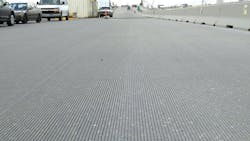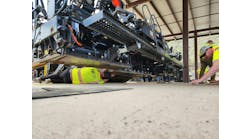By Jessica Porter, Contributing Author
Bridge decks are most slippery and prone to accidents during spring rains and winter weather. To increase safety, state departments of transportation increasingly require diamond grinding and grooving to be performed on bridge decks.
Diamond grooving channels water from the pavement surface to increase traction, reduce hydroplaning, and minimize splash and spray–increasing braking traction in wet, dangerous weather. Diamond grinding removes a thin layer of concrete to provide drainage, as well as reduce noise and improve smoothness, according to the International Grooving and Grinding Association (IGGA).
Both techniques have proven impacts on safety. In fact, the California Department of Transportation found longitudinal grooving resulted in a nearly 70% decrease in accident rates. The Wisconsin Department of Transportation found the overall accident rate for diamond-ground surfaces was only 60% of the rate for unground surfaces and experienced reduced accident rates up to six years after grinding.
“Not only does grinding improve the smoothness of surface texture, it also reduces the bumps and structural failures that may result in potholes and can cause vehicles to lose control,” said IGGA’s Director of Technical Services Nick Davis. “Grooving adds further macro texture that mitigates the dangers of black ice and hydroplaning.”
Because they inevitably experience slight movement, bridge decks are particularly susceptible to uneven surfaces that can lead drivers to lose control. Expansion joints that connect the pavement typically are installed to accommodate that movement.
“Bridges move even though they're not supposed to, so they add expansion joints to accommodate that movement. The sizes vary; we’ve worked on bridge decks where the joints are 23 feet wide,” said Scott Eilken, owner of Quality Saw & Seal. “Whether the joints are at the end or middle of a bridge, you try to gain smoothness over them.”
Many states now require diamond grooving on bridge decks to help make the pavement smoother. Though it’s been slower to catch on, states are beginning to recognize the value of grinding on bridge decks as well. When performed together, diamond grinding and grooving can significantly improve the driver experience on bridge decks.
The Grooving and Grinding Process
The grooving and grinding processes are completed using the same equipment, but with alterations like the diamond-tipped saw blades being placed at different increments.
When performing grooving, the machines use diamond-tipped saw blades that are mounted and spaced on a horizontal shaft to saw into the pavement surface. The saw blades are consistently cooled by water pumped from a tanker. Grooving machines typically cut transverse or longitudinal grooves that are 1/8-inch to 3/16-inch deep and approximately 1/8-inch wide, with spacing 3/4-inch center-to-center, according to IGGA.
When performing grinding, the machines use a series of closely spaced diamond-tipped saw blades mounted on a rotating shaft that’s typically 50-inches wide to remove approximately ¼-inch of pavement. The saw blades use abrasion to gently remove the surface layer without micro-cracking the aggregates. On bridge decks, in particular, grinding typically is performed longitudinally over the length of the bridge–including expansion joints–and full deck width, extending to within 2 feet of the parapets, according to IGGA.
Contractors like Quality Saw & Seal, Inc., based in Bridgeview, Ill., specialize in grinding and grooving on bridge decks with several different pavements, including concrete, latex overlay and modified wearing surfaces. Quality Saw & Seal works with manufacturers to determine the right products for each project’s unique specifications.
To complete each job successfully, the contractor must be intimately familiar with grinding and grooving machines, which involve complicated systems of parts to perform and can take years to learn how to operate and maintain correctly. Proper operation and maintenance are paramount to performing jobs as specified.
“Grinders and groovers have differences like the match wheels, vacuum systems, blower systems, and bearings around the diamond head on the machine. Match wheels make critical passes on decks and bearings can’t have issues because the head needs to stay level on the surface. These are all critical components,” Eilken said. “So these machines require a tremendous amount of maintenance.”
Eilken, who has been in the industry for more than 40 years, has a staff of equipment operators at Quality Saw & Seal whose roles are to run and maintain the machines. Operators work with the mechanic staff to ensure maintenance occurs as needed, monitoring work like oil changes, changing vacuum diagrams and maintaining match wheels. By requiring the operators to be responsible for maintenance, the machines are monitored for routine upkeep and unexpected repairs every day.
To find operators who are up to the task, Quality Saw & Seal relies on its union ties. Once an operator is hired, they are trained on how to run the machines, as well as how to handle the uniqueness of every jobsite, which can take years.
“Training involves learning how to deal with all scenarios on a jobsite. All jobs are different; the width and length of the decks, the expansion joints and the project location–each one is different,” Eilken said. “So jobsite scenario training is quite extensive.”
Performing diamond grinding and grooving are effective ways for states to repair bridge decks to increase safety and smoothness, improving the overall driver experience and decreasing accidents during slippery weather conditions. RB
Jessica Porter is a freelance writer and editor who specializes in construction. Contact her at [email protected] and visit her website at www.JessicaLynnePorter.com.



